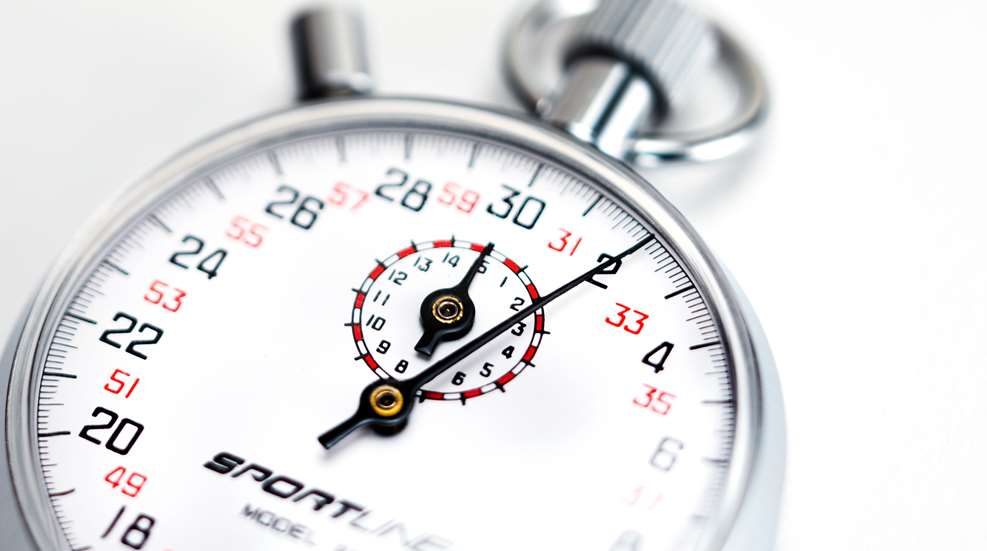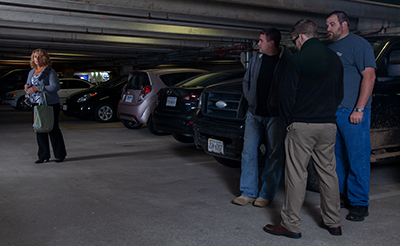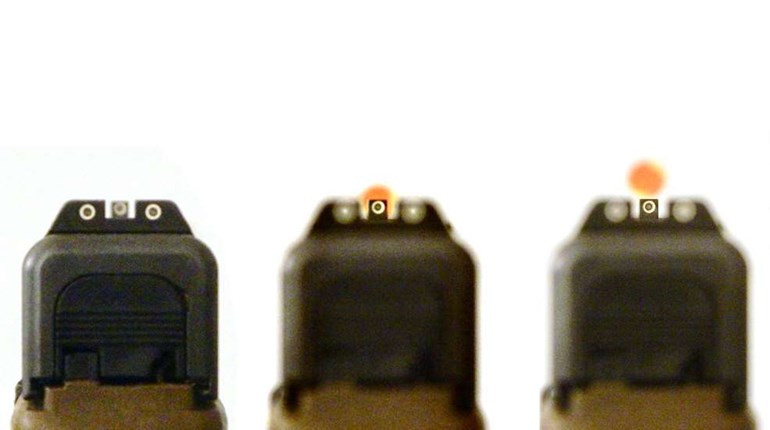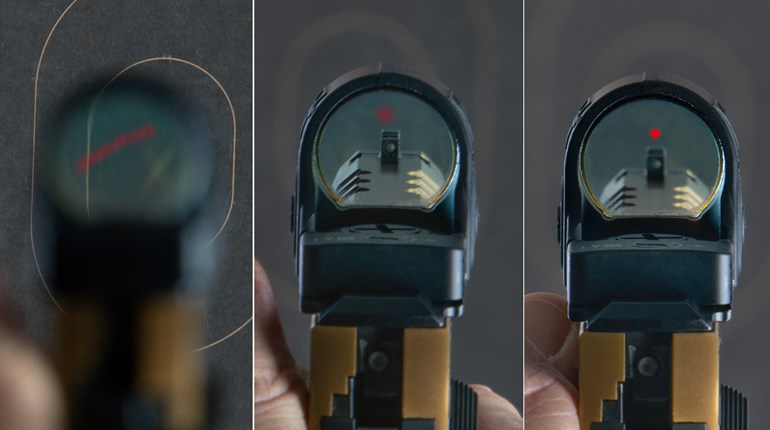
More space equals more time equals more opportunity to solve the tactical problem. The converse is also true: Less space equals less time equals fewer opportunities to solve the tactical problem. How can you create and control the reactionary gap affording you a tactical advantage when bad things happen to good people?
Referencing ballistic weapons (firearms), the capability of the gun (handgun or long gun) and the capability of the shooter determine the effective contact range. Long gunners, using a rifle, can strike far beyond or outside your line of sight using extreme distance, concealment, position, camouflage, etc.—which, of course, means you may not be able to see them, nor determine a specific distance.
Employing reactive measures at longer distances and under these extreme conditions is to identify the impact area and immediately seek cover. Use your sensory input to confirm that it is gunfire. Take a second to orient to the direction of incoming rounds, as you do not want to inadvertently run into a hailstorm of flying lead.
Crowded public areas have proven to be attractive targets for terrorists, predators and lunatics alike. There are five proactive measures you can take if you are considering attending a large public gathering (concert, sporting event, etc.) and in preparing for a long-distance attack.
Crowded public areas have proven to be attractive targets for terrorists, predators and lunatics alike. There are five proactive measures you can take if you are considering attending a large public gathering (concert, sporting event, etc.) and in preparing for a long-distance attack:
1. Don’t go. The simple and easy proactive measure to avoid becoming a victim at a large-scale event, is don’t show up. If you don’t show up, there’s a 100-percent guarantee you won’t be attacked. However, do you really want to stay behind closed doors and live in fear? No. So, there are at least four other proactive measures you can take and actually enjoy life.
2. Position yourself and those with you nearest readily accessible cover and/or exit points. The ability to use cover and/or egressing from an impact area is relative to your proximity to said cover or exit. The closer you are to those hard points, the less time it takes for you to use them. The farther away you are, the longer the distance you must travel, which increases the amount of time you are exposed to danger.
3. Should you need to go hard-and-fast mobile (such as the extremely unlikely need to dodge sniper fire), then you need to move as quickly as you are able. Physical disabilities, injuries or wearing restrictive clothing can hamper your mobility/speed. Tight clothing, high heels, loose flip-flops, etc., can also affect your movement. It is recommended that you wear footwear and clothing that will allow you to run at least 500 yards across a parking lot, through traffic, a train station or a large shopping mall.
4. It’s also a good idea to always have a compact bleeding/gunshot-wound trauma kit (including a tourniquet) on hand. Stopping blood loss is one of the most important steps you can take in treating a gunshot, shrapnel or a wound from an edged instrument.
Keeping a few medical supplies on hand could save your life, or the life of another. It is recommended to carry or have access to a basic gunshot wound (GSW) trauma kit including a tourniquet, combat gauze, control elastic wrap, chest seal and a space blanket. The form/size of your kit should be a factor in your consideration. Is it compact enough for everyday carry? Will you carry it in your purse, in your car, keep one at your office? Bottom line with a GSW kit is to win the fight, “stop the bleed, help them breathe, warm not freeze and get ready to leave.”
When you know you’re going to an event that may be considered an attractive target, then appropriately adjust your personal-security radar, apply good situational awareness and enjoy the show.
Creating more space between yourself and the shooter makes you a smaller target, staying mobile makes you a moving target and utilizing good cover all contribute to making you a much more difficult target for an active shooter. For non-ballistic weapons, such as an edged or impact weapon, the relationship between distance and injury is the same relationship between distance and reaction time.
The less space between you and the threat wielding a non-ballistic weapon, the less time you have to respond and the greater your susceptibility to injury. Conversely, the greater the space, the more response time and the lower your potential to sustain injury.

Time and Space
Reaction can only follow action, and thus there is a measurable amount of time between an undesirable event (someone shooting at you or trying to remove your brain-housing group with a machete) occurring and any response to that event.
Complex solutions have more moving parts that may fail in any situation, especially under duress. If you can’t pull off a reactive measure in less than 2 seconds, then it’s probably not going to work.
To best illustrate this principle, consider a baseball player in center field who observes that the batter has hit the ball. He watches the ball’s trajectory from the impact with the bat up and over the infield toward his location. Because of this tremendous amount of space, he has plenty of time to react and may even need to wait patiently for the ball to come down before catching it in his glove. The very next play, however, the pitcher may have only a split second to duck out of the way of a ball the batter has drilled straight at him. The difference between the two is a matter of time and space.
Further dissecting this relationship, the ball traveled through such a great amount of distance, the outfielder had plenty of time to react to the ball and catch it. Whereas the pitcher, due to the tremendous speed of the incoming projectile, had very little time to react. The more distance you have, the more time you have to react; the less distance available, the less time you have to react. This is the Reactionary Gap.
If a person moves physically closer to you, to engage in a conversation for example, they have made three measurable changes to your operational space. They have:
1. Closed the Reactionary Gap.
2. Positioned themselves at a distance where they are capable of making physical contact with your body.
3. Increased your potential for sustaining physical injury.
The instant an adversary is positioned at a distance where they can make physical contact with your body is the same instant that your potential for injury increases. In any threat environment, there are only two distances or ranges that you can be from a threat of non-ballistic weapons:
Non-contact Range—that distance which provides you the most space and time and is outside the potential for increasing your scale of injury.
Contact Range—commonly referred to as conversational range. This is the exact physical distance where you move from the safety of no injury to the raised potential of injury.
The safer of these two, in terms of physical threat management, is non-contact range. Your knowledge of the distance/injury relationship and controlling the reactionary gap will give you the advantage in managing a physical threat at conversational ranges.

The 2-Second Rule
Part and parcel of the reactionary gap is another important protective-services concept known as the 2-Second Rule. Most of us have heard the common phrase, “keep it simple.” In the world of professional protection, keeping it simple is considered a rule of thumb. Complex solutions have more moving parts that may fail in any situation, especially under duress. If you can’t pull off a reactive measure in less than 2 seconds, then it’s probably not going to work.
In the event of an active killer where your reactive measure is to locate and move to an exit in a crowded restaurant, we all know a straight line is the shortest distance between two points. However, based on whether it is a ballistic or non-ballistic weapon attack, you may need to identify and utilize cover and/or concealment along the way, which may cause you to veer off that straight-line trajectory.
When confronted by an adversary, the quicker you effectively respond, the more of an advantage you gain. If you happen to be engaged by an adversary at conversational ranges, your immediate reaction should take no more than 2 seconds.
Protection professionals place a maximum timeline of less than 2 seconds as part of any effective response. The reason for the 2-second rule comes from studies that have found that the average close-quarter threat engagement occurs at less than 10 yards—30 feet. The distance it takes a military-age male (between the ages of 18 and 32) to cover the distance of 10 yards or less is approximately 2 seconds. You must have the awareness and skill to control this reactionary gap.
Measuring the Reactionary Gap
Measurement of the reactionary gap starts with situational awareness. If you don’t hear it, see it or smell it coming, you will find yourself much further behind the action-reaction power curve than recommended.
The clock starts at the onset of an undesired event. Let’s use a parking lot scenario as an example of a potential high-threat environment. Practicing good situational awareness, you notice a small group of military-age males staring you down from 20 yards away. Raising your awareness to the next level, you further observe that they are moving toward you and reaching into their coat pockets.
The fact that you immediately identified several potential threat indicators affords you multiple tactical advantages.
You have identified a potential threat to yourself and those with you with a high likelihood of probability. You have eliminated any element of surprise, thus compromising their potential intended attack effectiveness. You have moved to the front end of the action-reaction power curve.
Applying good situational awareness buys you the desirable option of proactive measures—such as further increasing your distance from them, thus creating a greater reactionary gap, which in turn buys you more time and opportunity to solve the tactical problem. These are the advantages of controlling the reactionary gap.
Conversely, failure to apply situational awareness can significantly decrease your survivability. Failure to look for and identify potential threat indicators places you significantly behind the action-reaction power curve and relegates you to only reactive measures (as opposed to proactive measures) in solving the tactical problem.
Controlling the reactionary gap begins with situational awareness. You want the advantage of being able to apply proactive measures as opposed to reactive measures. However, applying good situational awareness is only part of the solution.
Once a potential threat has been identified, you must make an ad hoc plan on the move. After recognizing a problem, your next step is to solve that problem. What is the best solution? You can’t go wrong with creating more space as this increases the reactionary gap, which in turn increases your reaction time, buying you further options. In doing so, you may have increased the gap so much so that your attacker(s) may consider a softer target. However, it is possible that they may close the reactionary gap warranting an immediate solution to the problem.
Your options are either an exit plan—find a way out to get off that fateful ‘X’ and move to a safer physical position—or equalize use of force against the active threat. The safest of these two plans is to exit, which further increases your reactionary gap, allows for additional proactive measures and lowers your injury potential. The less safe of these two, and the option where you have no other choice, is to equalize against the threat; that is get something in your hands such as a ballistic or non-ballistic weapon with which you may effectively solve the tactical problem.
Either you control the reactionary gap, or the reactionary gap controls you. Armed with a compressed reactionary-gap briefing and the advantages of your controlling it as both a proactive and reactive measure. Knowing what it is, and how to create and control the reactionary gap affords you a tactical advantage should bad things happen to good people.





































